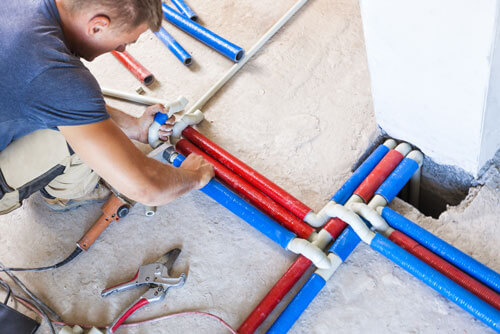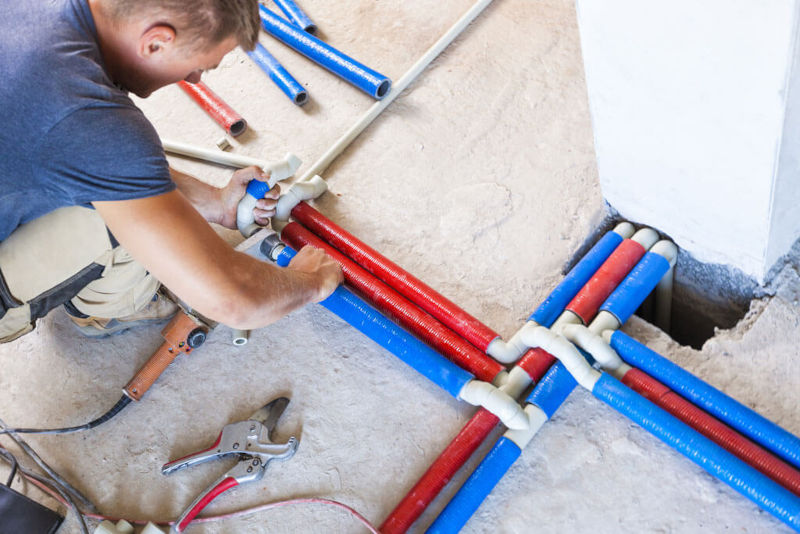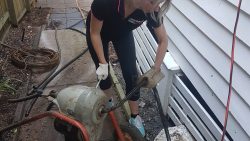
Exploring Different Plumbing Pipe Types:A Comprehensive Comparison

If you’re reading this article, chances are you’re wondering what type of plumbing pipe you should be using in your home or unit.
Before we dive into the nitty gritty, let’s make sure that you’re in the right place. The information we cover in this blog is targeted at Australian homeowners and focuses on domestic plumbing pipes from a maintenance plumbers’ perspective. The materials included in the comparison were selected for their widespread availability and popularity in Brisbane homes and apartments.
The number of plumbing pipe products available has never been greater. With so many materials available— Copper, PEX, Polly, PVC, Galvanized Steel—it’s no wonder homeowners are often confused about which one to pick.
The choice of pipe material isn’t just about cost—it impacts the durability and efficiency of your plumbing system. Whether you’re renovating, building new, or repairing, understanding these choices can feel overwhelming.
We aim to simplify this process by exploring the differences between various pipe materials, addressing common concerns, and (hopefully) guiding you towards an informed decision that suits your needs and budget.
Let’s jump in and help find the right pipe for your home!

Copper Pipe
Overview and common uses
Copper pipe is reliable, practical and suitable for a wide number of plumbing applications. While it is often labelled as expensive, there is a reason this product is still a go-to for most plumbers and gas fitters alike. It is reliable, long-lasting, easy to install and simple to repair. With the introduction of crimp fittings such as b-press, copper pipe is just as relevant as ever in today’s market.
Copper Pipe – The Gold Standard
Pros
Cons
Long-term value for the homeowner – Copper Pipe is Durable and long-lasting
Copper pipes and unions generally cost more than PEX and Polly.
Universal and easy to retrofit and repair
Depending on the job, copper can prove more time-consuming to install.
Can be used for cold, hot and gas pipework
Copper Crimp Fittings (B-Press) are not cheap and quickly add up on bigger jobs.
Easy to join via soldering, compression unions or crimp fittings.
Erosion-corrosion needs to be considered for reticulated hot water return lines (often seen in large unit blocks)
No nasty surprises – Copper is a tried and tested product that reliably delivers.
Copper Pipe – The Gold Standard
Pros
Long-term value for the homeowner – Copper Pipe is Durable and long-lasting
Universal and easy to retrofit and repair
Can be used for cold, hot and gas pipework
Easy to join via soldering, compression unions or crimp fittings.
No nasty surprises – Copper is a tried and tested product that reliably delivers.
Cons
Copper pipes and unions generally cost more than PEX and Polly.
Depending on the job, copper can prove more time-consuming to install.
Copper Crimp Fittings (B-Press) are not cheap and quickly add up on bigger jobs.
Erosion-corrosion needs to be considered for reticulated hot water return lines (often seen in large unit blocks)
Impact on homeowners’ experience
Opting for copper pipes can significantly impact your experience in multiple ways, most notably in terms of long-term value. While copper may have a higher upfront cost compared to other materials, its durability and longevity can offer a greater return on investment over time. Copper pipes are resistant to corrosion, can withstand extreme temperatures, and are less likely to leak, reducing the need for frequent repairs or replacements. In addition, using a single type of pipe material, like copper, throughout your home can help avoid a ‘spaghetti’ situation of mixed plumbing pipes. This common scenario can often lead to a nightmare when it comes to repairs, as understanding and troubleshooting a system with varied materials can be incredibly challenging. By selecting copper, homeowners can benefit from durable, long-lasting solutions resulting in easier maintenance and cost savings in the long run.
Pex Pipe
(Tradepex, Ozpex, Sharkbite, Waterpex, Pipapex etc.)
Overview and common uses
Pex pipe (Cross-linked polyethylene) is the newest generation in plumbing pipe technology. It uses a durable plastic composite to deliver a cost-effective plumbing solution. Due to its low cost and ability to be installed very quickly, it is extremely common in new builds. PEX can also be used in the retrofitting of existing pipes, given its ability to be snaked through walls much like electrical wiring. When using PEX pipe, it’s always a good idea to store some extra unions and pipe away for future works.
PEX Pipe – The New Kid On the Block
Pros
Cons
Low material cost when compared with copper.
The abundance of different products available can make choosing the right plumbing pipe types and the correct size difficult.
Fast and easy to install, HOWEVER, you must have the right tools for the specific brand of pipe.
Trying to identify and connect onto old PEX pipe is a plumber’s worst nightmare. This often results in a repair being time-consuming and costly.
Available in long lengths which is convenient for bigger jobs. This also allows for less connections.
Crimped fittings are more prone to leaks. This can be a problem down the track, especially if the joint is inside a roof or wall cavity.
Longer projected lifespan than polly pipe.
There are a number of limitations on where you can use PEX pipes. It is not suitable for outdoor use as it’s sensitive to UV light. It’s also not suitable for high temperature and high pressure services.
Resistant to scale and chlorine, and doesn’t corrode or develop pinhole leaks, which are common problems in some copper systems (i.e. hot water return lines).
Requires the use of specialised heads and crimping tools for repairs. These are often not readily available.
PEX Pipe – The New Kid On the Block
Pros
Low material cost when compared with copper.
Fast and easy to install, HOWEVER, you must have the right tools for the specific brand of pipe.
Available in long lengths which is convenient for bigger jobs. This also allows for less connections.
Longer projected lifespan than polly pipe.
Resistant to scale and chlorine, and doesn’t corrode or develop pinhole leaks, which are common problems in some copper systems (i.e. hot water return lines).
Cons
The abundance of different products available can make choosing the right type of pipe and the correct size difficult.
Trying to identify and connect onto old PEX pipe is a plumber’s worst nightmare. This often results in a repair being time-consuming and costly.
Crimped fittings are more prone to leaks. This can be a problem down the track, especially if the joint is inside a roof or wall cavity.
There are a number of limitations on where you can use PEX pipes. It is not suitable for outdoor use as it’s sensitive to UV light. It’s also not suitable for high temperature and high pressure services.
Requires the use of specialised heads and crimping tools for repairs. These are often not readily available.
Impact on homeowners’ experience
Before selecting PEX pipes for your home plumbing system, it’s important to weigh up the pros and cons. From a builder’s or plumber’s perspective, PEX is often a preferred choice due to its lower cost and ease of installation compared to other materials. However, this initial cost advantage may not always translate into long-term convenience for you, the homeowner. While PEX systems are generally reliable, any necessary repairs can create confusion due to the number of different products. As maintenance plumbing specialists, we often see this turn into a tangled and complex web, making future alterations or repairs more challenging. Hence, while PEX may offer initial cost savings, homeowners need to be aware of the potential complexities that may arise in the long run.
Polly Pipe
Overview and common uses
Polly pipe is a cost effective and readily used plumbing material. Not to be confused with irrigation pipe, which does not carry the blue stripe, blue line polly pipe is suited for use with potable water. Polly pipe is very common through houses in Brisbane and was the leading alternative to copper pipe prior to the recent rise in PEX. Polly pipe is most used on mains water services between the water meter and your house.
Polly Pipe – The Speedy Install
Pros
Cons
Cost effective.
Reduced life compared with Copper and Pex Pipe.
Fast and easy to install, especially for long underground runs.
Requires careful bedding in sand to ensure a long life.
Available in blue-line (drinking water/ potable) and black (irrigation/ non-potable)
Not suitable for locations with UV exposure.
Easier to identify and repair then PEX
Prone to damage during excavation.
Polly Pipe – The Speedy Install
Pros
Cost effective.
Fast and easy to install, especially for long underground runs.
Available in blue-line (drinking water/ potable) and black (irrigation/ non-potable)
Easier to identify and repair then PEX
Cons
Reduced life compared with Copper and Pex Pipe.
Requires careful bedding in sand to ensure a long life.
Not suitable for locations with UV exposure.
Prone to damage during excavation.
One of the primary advantages of polly pipes is their cost-effectiveness. They are generally cheaper than other materials such as copper or PEX, which can result in significant savings, particularly for larger projects. Additionally, polly pipes are lightweight and flexible, making them fast and easy to install. This can further reduce labour costs and expedite the installation process. However, it’s important to consider that polly pipes typically have a shorter lifespan compared to more durable options like copper or PEX. As such, while they can be a great choice for short-term or temporary water services, they may not be the best option for those seeking a long-term solution for their residential plumbing system. The need for potential replacements down the line should be factored into the overall cost and convenience considerations when selecting polly pipes.
Need assistance with your hot water system?
Please call, and we will be able to assist you today.
Call: (07) 3878 4444
We’ve got a brilliant team on the ground right now who’ll give you real, honest advice and a great price. And all our work is 100% guaranteed.
Tips and Advice for Homeowners

Considerations when Selecting Pipe Materials for Home Renovations
When selecting plumbing pipe types for your home, it’s vital to consider the long-term implications of your choice. Copper, while more expensive upfront, is durable, long-lasting, and easy to repair. It’s also suitable for all types of pipework—cold, hot, and gas. On the other hand, PEX and polly pipes are more cost-effective and easy to install, making them a preferred choice for some builders and plumbers. However, PEX can cause confusion, and both PEX and polly can have a reduced lifespan compared to copper. Your decision should be based on a balance of factors including cost, durability, ease of installation, and longevity.
What to Do When Facing Plumbing Issues
As a first step when a plumbing issue arises, we recommend switching off your water supply at the mains to prevent further damage. When plumbing issues arise, the type of pipe you have can greatly influence the repair process. Copper pipes are relatively straightforward to fix but require specific tools and knowledge. PEX and pipes, while initially easier to install, can become difficult and time consuming to repair.
Importance of Consulting a Professional Plumber
Don’t risk it – Use a licenced plumber! While DIY solutions can be tempting, consulting a professional plumber will save you time, money and (most of all) reduce stress in the long term.
A professional plumber will have the knowledge and experience to understand the intricacies of different pipe materials. They can provide advice on the best type of pipe for your specific needs and handle installations or repairs safely and efficiently. Additionally, some plumbing work may be subject to local building codes and regulations, which a licenced plumber would be familiar with. By consulting a professional, you can ensure your plumbing system is robust, safe, and long-lasting.
The verdict:
We hope this article has armed you with a deeper understanding of the key differences among copper, PEX, and polly pipes. The selection isn’t just about cost; it’s also about the impact on your plumbing system’s durability, efficiency, and upkeep. Armed with the knowledge of each pipe’s pros, cons, and common uses, homeowners can make decisions tailored to their specific needs and budget. This choice directly influences the comfort of their living experience and the longevity of their homes.
As maintenance plumbers, we tend to prefer copper pipes in the majority of situations due to its reliability and robustness. For larger projects, PEX pipes are increasingly favoured for their affordability and quick installation. Despite its waning popularity, polly pipe still retains its role for certain repairs and maintenance tasks. Your choice should reflect your unique requirements, expectations, and budget constraints.
Can we help you?
When it comes to maintenance plumbing, Conrad Martens Plumbing & Hot Water has you covered! For expert advice and assistance in Brisbane, Australia, call us on (07) 3878 4444. We pride ourselves on providing same day service and can help repair copper, polly and pex pipes. We’re here to help when you need it most!
Conrad Martens Plumbing & Hot Water does not specialise in project work, major renovations or new house constructions. For this work, we recommend getting in touch with a builder or project plumber.
Yours in keeping the good life flowing!
The Conrad Martens Team
For the best price, service and advice!




